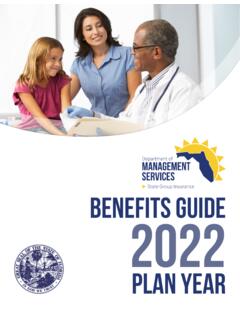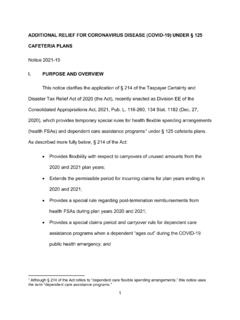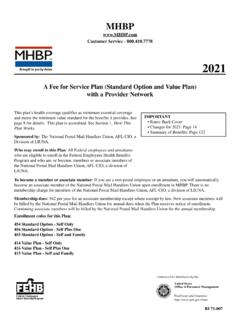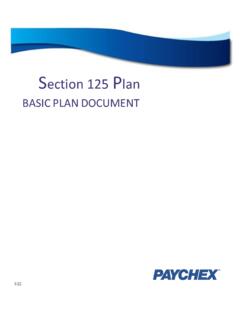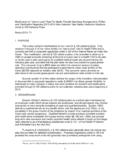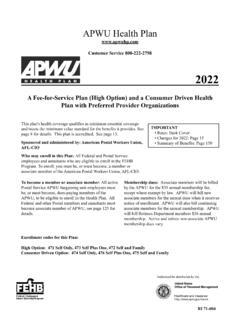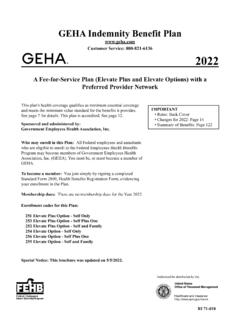Transcription of ERISA and, with one exception, the PHS Act.
1 1 Part III - Administrative, Procedural and Miscellaneous Qualified Small Employer health Reimbursement Arrangements Notice 2017-67 PURPOSE This notice provides guidance on the requirements for providing a qualified small employer health reimbursement arrangement (QSEHRA) under section 9831(d) of the Internal Revenue Code (Code), the tax consequences of the arrangement, and the requirements for providing written notice of the arrangement to eligible employees. BACKGROUND The 21st Century Cures Act (Cures Act), 114-255, 130 Stat. 1033, was enacted on December 13, 2016. Section 18001 of the Cures Act amends the Code, the Employee Retirement Income Security Act of 1974 ( ERISA ), and the Public health Service Act (PHS Act), to permit an eligible employer to provide a QSEHRA to its eligible 1 On December 20, 2016, the Department of Labor, the Department of the Treasury, and the Department of health and Human Services (collectively, the Departments) issued FAQs About Affordable Care Act Implementation (Part 35), Q&A-3 ( ) concerning the Cures Act.
2 That guidance continues to apply. 2 Pursuant to section 9831(d)(1), a QSEHRA is not a group health plan, and as a result, is not subject to the group health plan requirements that apply under the Code, ERISA and, with one exception, the PHS Generally, payments from a QSEHRA to reimburse an eligible employee s medical expenses are not includible in the employee s gross income if the employee has coverage that provides minimum essential coverage (MEC) as defined in section 5000A(f).3 For this purpose, medical expenses means expenses for medical care, as defined in section 213(d) (which includes premiums for other health coverage, such as individual health insurance policies). The Cures Act provides that a QSEHRA is an arrangement that meets the following criteria: (a) The arrangement is funded solely by an eligible employer, and no salary reduction contributions may be made under the arrangement; (b) The arrangement provides, after the eligible employee provides proof of coverage, for the payment or reimbursement of the medical expenses incurred by the employee or the employee s family members4 (in accordance with the terms of the arrangement); 2 A QSEHRA continues to be treated as a group health plan under the PHS Act for purposes of part C of title XI of the Social Security Act.
3 3 MEC is defined in section 5000A(f) and the regulations thereunder. See Appendix A to this notice for a list of examples of plans and arrangements that are MEC, as provided in the 2016 Instructions for Form 8965, health Coverage Exemptions (and Instructions for Figuring Your Shared Responsibility Payment). 4 For purposes of this notice, family member of an eligible employee means any individual for whom an employer s reimbursement of the individual s medical expenses would be excluded from the eligible employee s gross income under section 105(b). 3 (c) The amount of payments and reimbursements described in paragraph (b) of this section for any year does not exceed $4,950 ($10,0005 for an arrangement that also provides for payments or reimbursements of medical expenses of the eligible employee s family members (family coverage)); and (d) The arrangement is generally provided on the same terms (the same terms requirement ) to all eligible employees of the eligible employer.
4 To be an eligible employer that may provide a QSEHRA, the employer must not be an applicable large employer (ALE), as defined in section 4980H(c)(2) and the regulations thereunder (and, thus, may not be an employer that, generally, employed at least 50 full-time employees, including full-time equivalent employees, in the prior calendar year), and must not offer a group health plan (as defined in section 5000(b)) to any of its employees. Pursuant to section 4980H(c)(2), an employer whose workforce increases to 50 or more full-time employees during a calendar year will not become an ALE before the first day of the following calendar year. In addition, Executive Order 13813 (82 Fed. Reg. 48385, Oct. 17, 2017), directed the Secretaries of the Treasury, Labor, and health and Human Services to consider revising guidance, to the extent permitted by law and supported by sound policy, to increase the usability of health reimbursement arrangements (HRAs), expand employers ability to offer HRAs to their employees, and to allow HRAs to be used in conjunction with non-group coverage.
5 The guidance provided in this notice addresses 5 Section 9831(d)(2)(D)(ii) provides that both statutory dollar limits are adjusted for inflation beginning after 2016. This adjustment increased the $10,000 limit to $10,050 for a QSEHRA provided in 2017; the adjustment did not increase the $4,950 limit for 2017. The adjusted limits for 2018 are $5,050 for self-only coverage and $10,250 for family coverage. 4 each of those objectives. The Treasury Department (Treasury) and the Internal Revenue Service (IRS) anticipate that the Departments will issue additional guidance in the future in response to Executive Order 13813. GUIDANCE This guidance includes sections on the following topics: A.
6 Eligible employer B. Eligible employee C. Same terms requirement D. Statutory dollar limits E. Written notice requirement F. MEC requirement G. Proof of MEC requirement H. Substantiation requirement I. Reimbursement of medical expenses J. Reporting requirement K. Coordination with PTC L. Failure to satisfy the requirements to be a QSEHRA M. Interaction with HSA requirements N. Effective date A. Eligible employer Under section 9831(d)(3)(B)(ii), eligible employer means an employer that does not offer a group health plan (including a health reimbursement arrangement (HRA) or a health flexible spending arrangement (FSA)) to any of its employees. A group health plan includes a plan that provides only excepted benefits described in section 9831(c) (for example, a vision or dental health plan that qualifies as an excepted benefit) if that plan is offered by an employer to its employees.
7 If an employer endorses a particular policy, form, or issuer of individual health insurance, the coverage may constitute a group health plan. However, providing employees with information about the Affordable Insurance Exchange, also called a 5 health Insurance Marketplace (Marketplace), or the premium tax credit (PTC) under section 36B, is not an endorsement of a particular policy, form, or issuer of health insurance. Question 1: Does an employer fail to be an eligible employer if it offers a group health plan to former employees (for example, retirees)? Answer 1: No. For purposes of the QSEHRA requirements, former employees are not treated as employees. As a result, offering a group health plan to former employees does not cause the employer to fail to be an eligible employer.
8 Question 2: Does an employer fail to be an eligible employer if it provides current employees with continued access to amounts that were accumulated in an HRA in prior years or carryover amounts in an FSA? Answer 2: Yes, but an employer does not fail to be an eligible employer if it suspends access to amounts accumulated in an HRA in previous years (such that they cannot be used for any purpose) during the period a QSEHRA is provided to its eligible employees. Question 3: Does an S corporation fail to be an eligible employer if, separate from a QSEHRA, it reimburses the health insurance policy premiums of a 2-percent shareholder (as defined in section 1372(b)) who is an employee? Answer 3: No. But see Q&A-9 regarding the status of an owner as an eligible employee.
9 Question 4: Does an employer fail to be an eligible employer for any month during which it offers a group health plan? 6 Answer 4: Yes. An employer is not an eligible employer for any month during which the employer offers a group health plan to its employees that would provide coverage on any day of the month. Thus, for example, in the case of a non-calendar year group health plan, the employer is not an eligible employer for those months of a calendar year during which the group health plan is offered. Question 5: If one employer in a group of employers that are treated as a single employer under section 414(b), (c), (m), or (o) offers its employees a group health plan, may any other employer in the group be an eligible employer?
10 Answer 5: No. Question 6: Does an employer fail to be an eligible employer if it contributes to an employee s health savings account (HSA), including permitting an employee to make pre-tax contributions to the HSA, by salary reduction, through a cafeteria plan? Answer 6: No. Question 7: When does an employer fail to be an eligible employer if it provides a non-calendar year QSEHRA and becomes an ALE? Answer 7: The employer fails to be an eligible employer as of January 1 of the year it becomes an ALE. That is, if an employer increases in size during the current year so that it employs an average of at least 50 full-time employees (and full-time equivalent employees) on business days during the current year, then it is an ALE on January 1 of the next year and ceases to be an eligible employer on that date.










